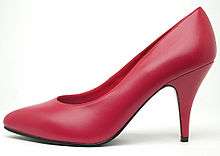Spool heel
A spool heel is a heel that is wide at the top and bottom and narrower in the middle,[1] so resembling a cotton reel or an hourglass.[2] Spool heels were fashionable in Europe during the Baroque[3] and Rococo[4] periods. Its other periods of popularity include the 1860s[5] and the 1950s.[6] This look has been popularized by John Fluevog.
A low spool heel has a small distinctive flare at the heel bottom. Higher spool heels are close to resembling a stilleto heel, but with a flare at the bottom.
Spool heels provide a lot of comfort for the wearer and are considered a more practical heeled shoe option.
References
- ↑ Chambers, Bernice Gertrude (1942). Color and design in apparel. Prentice-Hall. p. 462. OCLC 1703151.
- ↑ Pratt, Lucy; Linda Woolley (1999). Shoes. Victoria and Albert Museum. p. 124. ISBN 978-1-85177-285-8.
- ↑ Baker, Georgia O'Daniel (2000). A handbook of costume drawing: a guide to drawing the period figure for costume design students. Focal Press. p. 94. ISBN 978-0-240-80403-3.
- ↑ Girotti, Eugenia (1996). Footwear. Chronicle Books. p. 92. ISBN 978-0-8118-1469-0.
- ↑ Barton, Lucy (1963). Historic costume for the stage. W. H. Baker. p. 441. OCLC 331332.
- ↑ Probert, Christina (1981). Shoes in Vogue since 1910. Abbeville Press. p. 52. ISBN 978-0-89659-241-4.
This article is issued from
Wikipedia.
The text is licensed under Creative Commons - Attribution - Sharealike.
Additional terms may apply for the media files.
